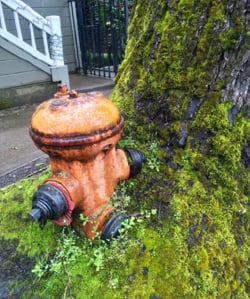 Imagine the following scenario: Firefighters are dispatched to a local residence where fire is showing from the second-story front window. Arriving on the scene, the firefighters begin to evaluate potential water sources, spot a fire hydrant on the street, and head toward it to establish a water supply. As they reach the hydrant, they realize it’s not operational—it’s completely consumed by a tree and vegetation! They’ll be lucky if they can open just one of the outlets, especially after noting a red tag displaying “out of service” in faded letters.
Imagine the following scenario: Firefighters are dispatched to a local residence where fire is showing from the second-story front window. Arriving on the scene, the firefighters begin to evaluate potential water sources, spot a fire hydrant on the street, and head toward it to establish a water supply. As they reach the hydrant, they realize it’s not operational—it’s completely consumed by a tree and vegetation! They’ll be lucky if they can open just one of the outlets, especially after noting a red tag displaying “out of service” in faded letters.
An out-of-service hydrant due to vegetation growth is just one of many worst-case scenarios that can greet fire service personnel at the scene of a fire. Blocked hydrants, closed underground valves, and broken hydrant stems are all conditions that can substantially hinder a fire department’s ability to mitigate damage to property, protect the health and wellness of occupants in surrounding buildings, and provide for firefighter safety during fire operations.
Which agency was responsible to maintain or replace fire hydrants in that community, the fire department or the water provider? Did one agency fail to notify the other of a potential issue? Was a notification made but proper maintenance steps not taken to resolve the issue? An inoperable hydrant is a major cause for concern for both agencies, regardless of when the issue was found and which agency was responsible. Firefighters rely on water providers and their water supply systems to perform as expected during chaotic and life-threatening situations. Water providers rely on fire departments to keep facilities in working order as much as possible because irregular or incorrect usage can also cause broken hydrants.
A close working relationship between fire departments and local water providers is crucial to avoiding such situations. Ideally, the interaction between the two agencies will provide opportunities to cooperate on hydrant placement, maintenance, inspection, and flow testing. Unfortunately, at times there is friction between water providers (which can be publicly funded or privately owned) and fire departments (which can be career, volunteer, combination, publicly funded, or privately owned). Leaders of both agencies must address questions of liability and responsibility to make sure that issues such as inoperable hydrants are limited and that there’s a process established to manage out-of-service hydrants efficiently.
ISO’s Fire Suppression Rating Schedule (FSRS) recognizes a community’s overall fire suppression capabilities by evaluating three key components: fire departments, water supply, and emergency communications systems, with extra credit for community risk reduction. The fire department and water providers play key roles in obtaining the highest rating possible, as their combined scores make up 90 of the 105.5 points possible (emergency communications account for 10 points, with 5.5 points extra credit for community risk reduction).
Since the FSRS establishes a community-based evaluation system, the same applicable credit for hydrant maintenance, inspection, and flow testing is given whether the functions are handled by the fire department or water provider for a given area. When a community is serviced by multiple water providers, the applicable credit for maintenance, inspection, and flow testing is given based on the percentage of hydrants each water system supplies to the community.
Community fire suppression is dependent on multiple agencies and engineered fire protection systems, including fire alarms, sprinkler and standpipe systems, fire department apparatus, hydrant systems, and communications systems. It requires cooperation between agencies, strict equipment maintenance, and attention to applicable national standards to make sure of the best outcome on any given day. Agencies can contact our Public Protection Classification (PPC®) customer support team at isomitigation.com or 1-800-444-4554 at any time with questions regarding FSRS credit items.
